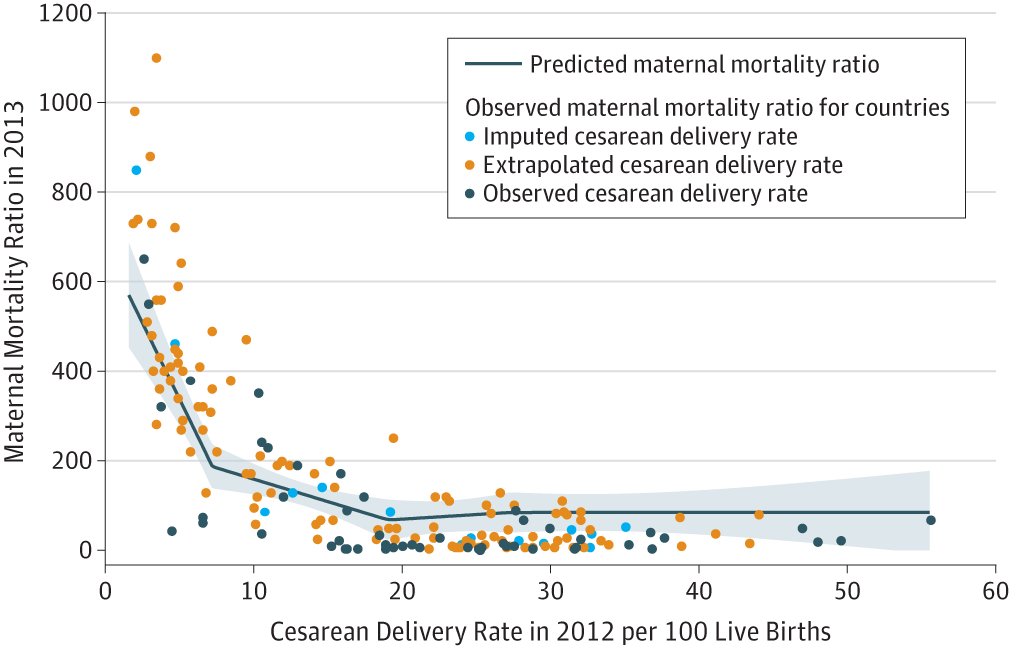Advertisement
Study Suggests 19 Percent Could Be Benchmark C-Section Rate
Ask 10 different obstetricians what the optimal cesarean delivery rate is and you'll likely get 10 different answers. But there is widespread agreement that 32.2 percent, the U.S. average in 2014, is too high. Way too high in light of research out Tuesday that finds no benefit in preventing death for the mother or infant when C-section rates rise above approximately 19 percent.
The findings, published in the Journal of the American Medical Association, are based on 2012 mortality rates from the 194 World Health Organization (WHO) member countries. There's a dramatic range, from South Sudan where just 0.6 percent of deliveries were by C-section, to Brazil where the rate was 55.6 percent.
Study authors say they are not presenting 19 percent as an ideal rate, but rather as a benchmark above which doctors need to consider: "We're unlikely to be improving maternal mortality or neonatal mortality, are there other benefits or harms to doing cesarean sections?" says Dr. Alex Haynes, a lead author on the study who works in the safe surgery program at Boston-based Ariadne Labs. The research was done in collaboration with Stanford University Medical School.
In the U.S., and in Massachusetts where the C-section rate is 31.6 percent, doctors say having a number, like 19 percent, will make a difference in doctor's offices and in hospitals.

"This will push all of us to say, what general practices contribute to inappropriate cesarean deliveries and how, with individual patients, can we make decisions about when it's necessary?" said Dr. Jeffrey Ecker, a high-risk obstetrician at Massachusetts General Hospital and chair of the committee on obstetric practice for the American College of OBGYNs, which does not have a target number for cesarean delivery.
Nineteen percent is higher than a 10 to 15 percent C-section range recommended by the WHO for roughly three decades. The WHO revised its recommendation in April, and no longer suggests an optimal or ideal rate, Dr. Ana Pilar Betrán, with the WHO's Department of Reproductive Health and Research, said in an email.
"The important message," Betrán said, "was that rather than striving to achieve a specific rate, every effort should be made to provide cesarean sections to women in need."
Betrán did not comment on the paper's findings or the value of using 19 percent as a C-section benchmark. And it makes some leaders in the U.S. movement to measure health care quality nervous.
"I don't want the surgeons sharpening the scalpels just yet," said Leah Binder, president and CEO of the Leapfrog Group, an employer backed health care rating organization that tracks C-section rates by hospital in the U.S. "We're talking about young women, many of whom are healthy and I hate to think that one in five needs to have major abdominal surgery in order to have a baby."
The report's authors do not recommend applying the 19 percent benchmark to individual patients, physician practices or hospitals. And they point out that an optimal rate might be higher or lower than 19 percent if benefits or harms other than death are taken into account.
A cesarean section can prevent harm, such as prolonged periods of low oxygen for the infant or a massive hemorrhage for the mother. On the flip side, the procedure itself can be risky and may make future pregnancies more dangerous. None of these risks or benefits are included in the 19 percent finding.
"That’s why I would refrain from being hard and fast about a 19 percent rate as being an ideal," said Hanyes, the study author.
Some childbirth quality experts say that while 19 percent seems like a good dividing line for C-sections that save lives and those that don't, given the status quo, it could be lower.
"We could shift this number downward," said Carol Sakala, director of childbirth connection programs at the National Partnership for Women and Families, by helping women get "fit and ready for the challenges of labor, using a doula, being upright and moving around during labor and periodic listening to the baby's heart patterns as opposed to continuous electronic fetal monitoring."
Sakala said she's worried about how the benchmark will be interpreted in countries that are currently under 19 percent and would have to build out their surgical capacity to offer more women a cesarean delivery.
"Wherever we've had capacity building in the past, C-section rates have gotten out of hand and have the potential to lead to overuse," said Sakala, who mentions China, India, Mexico and Brazil as examples of countries where C-section rates have risen sharply in recent years.
There is growing interest in the U.S in penalizing physicians who perform too many C-sections and rewarding those who perform fewer.
"There's no question we need to start to do that," said Leapfrog Group's Binder. "Right now we do the opposite, we reward physicians for resorting to C-section too often. If you do more C-sections, you will make more money, and that's not good for anyone."
There's no agreement yet on an appropriate C-section rate that would trigger penalties or rewards. In Massachusetts, health plans include rates for both early elective deliveries and C-sections in a list of quality measures that can be used to tier hospitals. If plans use this measure, then it may cost more to use hospitals that allow early elective deliveries or have a high C-section rate.
But what's "high?" That's the lingering question.
If you want to compare childbirth at hospitals across Massachusetts, check out our interactive map that looks at C-section rates and more. (One note: The state average used on the map, 21.2 percent, is different from the average used in this article because on the map we compare just first-time C-sections, not all cesarean deliveries.)
